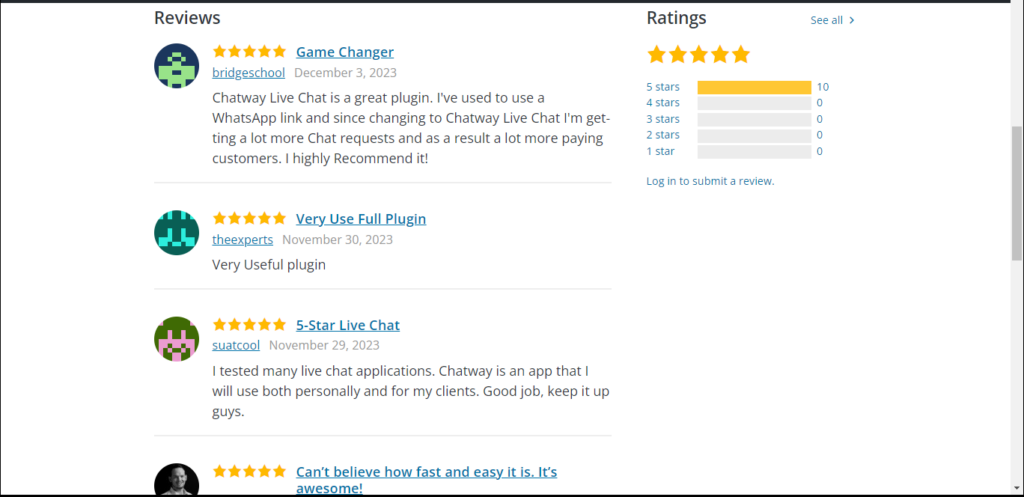
Damilola Oyetunji
Content Writer at Chatway.
Quickly respond to customer and visitor inquiries via live chat
Personalize the chat widget to match your business's style and branding
Stay updated on all incoming messages with email and push notifications
Improve the way your team works with chat assignments and private notes
Provide support on the go with Chatway's mobile apps for iOS and Android devices
Categorize and label conversations using specific criteria for personalized support
Interact with visitors in their preferred language, supporting 20+ languages
Use Chatway live chat on multiple platforms such as Shopify, Wix, Duda etc
Get insights into your support activities to better understand customer interactions
Centralize chats from Messenger and email into a single dashboard
Customer Service,Live Chat,Support - 7 Mins READ
Content Writer at Chatway.

Imagine this: a potential customer visits your website, browses your products, but leaves without making a purchase because they couldn’t get their questions answered quickly. This scenario is all too common for small businesses striving to make their mark in an increasingly competitive industry. The key to capturing and retaining customer interest lies not just in what you offer, but also in how quickly and effectively you engage with them. This is where live chat software comes into play, offering a real-time solution to one of the most pressing challenges faced by small businesses today: maintaining a high level of customer service with limited resources. Far from being a mere convenience, live chat has evolved into a vital tool for enhancing customer experience, boosting sales, and building long-lasting relationships.

In this article, we explore the impact of live chat for small businesses. We also delve into how it can help small businesses like yours not only meet but exceed customer expectations, providing a level of service typically associated with larger organizations. From increasing engagement to reducing response times and improving overall customer satisfaction, live chat is an indispensable asset in your customer support arsenal.
Live chat software is an online customer service tool that allows businesses to communicate with visitors on their website in real time. It typically appears as a chat widget enabling instant messaging between the customer and a representative of the company. This software aims to provide quick answers to queries, resolve issues efficiently, and enhance the overall customer experience. See a sample below of a live chat software (Chatway) on a website.

Here are seven key benefits of implementing a live chat widget on your website as a small business owner:
1. Improved Customer Experience: Live chat offers immediate assistance, enhancing customer satisfaction and loyalty by addressing queries and concerns in real-time.
2. Increased Sales and Conversion Rates: Real-time support during the purchasing process can alleviate customer hesitations, leading to higher sales and conversion rates.
3. Cost-Effective Customer Service: Live chat is more economical than traditional phone support, as representatives can handle multiple chats simultaneously, reducing staffing needs.
4. Better Understanding of Customer Needs: Chat histories provide insights into common customer inquiries, helping you tailor your offerings more effectively.
5. 24/7 Availability: With automation and chatbots, your business can provide assistance around the clock, catering to customers in different time zones or with varying schedules.

6. Building Trust and Credibility: Offering live support can enhance your business’s credibility and foster trust among customers, knowing that help is readily available.
7. Reducing Cart Abandonment: Live chat can significantly reduce cart abandonment rates in e-commerce by promptly addressing customer questions or concerns during the checkout process.
While exploring live chat solutions for small businesses, it’s important to consider a variety of options to find the one that best fits your business needs. Among the many available, Chatway is a notable example, known for its free plan, user-friendly interface and comprehensive features tailored for small businesses.

However, it represents just one of many solutions in a diverse market.
To provide a balanced perspective, let’s also consider other live chat software like Tawk.to, known for its free pricing model, and Zendesk Chat, which is renowned for its extensive capabilities. Each of these platforms has its unique strengths and can be suitable for different types of small businesses, depending on specific requirements such as budget constraints, desired features, and the level of customer interaction needed.
By comparing various options, you can gain a broader understanding of what’s available and make an informed decision that aligns with your business goals. Remember when choosing a live chat tool to not favor the most popular tool, but rather the one that integrates seamlessly with your business operations and enhances your customer engagement strategy.
When choosing a chat widget for your website, there are several factors to consider to ensure it meets your needs. Here’s a list of considerations:
1. User Interface Design: The chat widget should have a user-friendly interface that is easy to navigate. It should be intuitive for both first-time and returning visitors. The design should also be customizable to match your website’s aesthetics.
2. Responsiveness and Compatibility: Ensure the widget is responsive and works seamlessly across different devices and browsers. It should offer a consistent experience on desktops, tablets, and smartphones.
3. Customization Options: Look for a widget that allows customization in terms of colors, fonts, and layout. This helps in maintaining brand consistency across your website.
4. Integration Capabilities: The chat widget should easily integrate with your existing CRM, email marketing tools, and other software used in your business. This integration can help streamline customer data management.
5. Artificial Intelligence and Automation: Features like AI-driven responses and chatbots can enhance the efficiency of customer interaction, especially for handling common queries and after-hours support.
6. Real-Time Communication: The widget should facilitate real-time conversations, minimizing delays in response and improving customer satisfaction.
7. Data Security and Privacy: Ensure the chat widget complies with data protection regulations and maintains high standards of user data privacy and security.
8. Support and Maintenance: Consider the level of technical support offered by the provider. Reliable customer support and regular updates are essential for the smooth functioning of the widget.
9. Analytics/Reporting Tools: The widget should offer analytics to track user engagement, and other metrics that can inform business strategies.
10. Language Support and Localization: If your business caters to a global audience, look for a widget that supports multiple languages and can be localized for different regions.
11. Cost-Effectiveness: Evaluate the pricing models of different chat widgets. Consider both initial costs and long-term expenses, including any additional fees for premium features or updates.
12. User Feedback and Reviews: Check user feedback and reviews to understand the pros and cons of different chat widgets from a customer’s perspective.

13. Ease of Installation and Setup: The widget should be easy to install and configure without requiring extensive technical knowledge.
14. Scalability: Ensure that the chat widget can scale according to your business growth and can handle increasing volumes of customer interactions effectively.
15. Offline Functionality: The widget should offer offline messaging options so that customers can leave messages when live support is not available.
By evaluating these factors, you can choose a chat app that enhances customer interaction and aligns with your business objectives.
When implementing live chat in a small business, there are several common mistakes to avoid to ensure the tool is effective and adds value to both the customer experience and the business. Here are key points to consider:
Avoid long wait times. Customers choose live chat for its immediacy, so ensure that response times are as short as possible.
Ensure your support team is well-trained not only in using the live chat software but also in customer service etiquette. They should be knowledgeable about your products/services and capable of handling a range of inquiries.
While automated responses and chatbots can be helpful, relying on them too much can frustrate customers. Balance automated elements with personal interaction.
Failing to analyze chat transcripts and metrics can lead to missed opportunities for improvement. You can use this data to understand customer needs, common issues, and overall performance.
Identify and be available during your website’s peak traffic times. If 24/7 coverage is not feasible, clearly communicate your chat hours on your website.
Treat each customer interaction uniquely. Avoid using overly generic responses that don’t address specific customer needs.
Post-chat follow-ups can be crucial for customer satisfaction and feedback. They show customers that you value their experience and are committed to continuous improvement.
Set clear expectations about response times, especially if live agents are not available 24/7. This helps manage customer expectations and reduces frustration.
By avoiding these mistakes, you can make the most out of live chat for improving customer service and driving sales.
Engaging with your customers through live chat is a strategic move to improve your business’s customer service and sales. As you’ve seen from the insights shared in this article, implementing live chat can significantly benefit your small business.
Explore the possibilities with Chatway, a live chat solution tailored for the unique needs of small businesses. You can sign up now for a free version and start enjoying the benefits of real-time customer communication.

Content Writer at Chatway.

Content Writer at Chatway.

Live Chat - 7 Mins READ
Content Writer at Chatway.